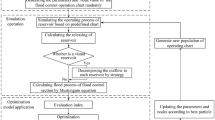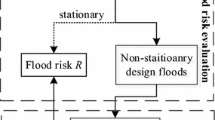Abstract
The dynamic control bound of flood limited water level (FLWL) is a fundamental and key element for implementing reservoir FLWL dynamic control. Due to the uncertainty of the inflow and the dimensional increase of the reservoirs, the calculation of the dynamic control bound of FLWL becomes more and more complicated. A new model that considers capacity compensation regulation and the uncertainty of flood spatial pattern (FSP) for a serial multipurpose reservoir system is developed to calculate the dynamic control bound of FLWL. This model consists of three modules: a compensation regulation module to analyze the feasibility to raise the FLWL and calculate the probable maximum upper bound of the FLWL, a risk control module containing a risk constraint to control flood risk and a Copula function to describe the uncertainty of the FSP, and a simulation operation module to simulate the flood control operation for cascade reservoirs. The proposed model was applied to Pankou-Huanglongtan cascade reservoirs in Du River basin. The application results showed that: 1) the proposed model could give a sufficient consideration about the uncertainty of the FSP, thus a safe and reasonable dynamic control bound of FLWL was derived. 2) the upper FLWL of Huanglongtan reservoir could rise up to 247.64 m from 247.00 m without increasing flood control risk and Huanglongtan reservoir could generate 9 and 7 billion kW.h extra hydropower energy during flood season in wet year 2000 and in dry year 1994, respectively.








Similar content being viewed by others
References
Ahmed JA, Sarma AK (2005) Genetic algorithm for optimal operating policy of a multipurpose reservoir. Water Resour Manag 19:145–161
Chen J, Guo S, Li Y, Liu P, Zhou Y (2013) Joint operation and dynamic control of flood limiting water levels for Cascade reservoirs. Water Resour Manag 27:749–763
Chowdhary H, Escobar LA, Singh VP (2007) Identification of suitable copulas for bivariate frequency analysis of flood peak and flood volume data. Hydrol Res 4(2–3):193–216 Social Sciences Academic Press
Eum HI, Simonovic SP (2010) Integrated reservoir management system for adaptation to climate change: the Nakdong River basin in Korea. Water Resour Manag 24:3397–3417
Favre AC, Adlouni SE, Perreault L, Thiémonge N, Bobée B (2004) Multivariate hydrological frequency analysis using copulas. Water Resour Res 40:290–294
Jenq–Tzong S, Wang HY, Chang–Tai T (2007) Bivariate frequency analysis of floods using copulas. Jawra Journal of the American Water Resources Association 42:1549–1564
Karmakar S, Simonovic SP (2009) Bivariate flood frequency analysis. Part 2: a copula-based approach with mixed marginal distributions. Journal of Flood Risk Management 2:32–44
Labadie JW (2005) Optimal operation of Multireservoir systems: state-of-the-art review. J Water Resour Plan Manag 130:93–111
Li X, Guo S, Liu P, Chen G (2010) Dynamic control of flood limited water level for reservoir operation by considering inflow uncertainty. J Hydrol 391:124–132
Liu P, Li L, Guo S (2015) Optimal design of seasonal flood limited water levels and its application for the three gorges reservoir. J Hydrol 2015(527):1045–1053
Long LN, Madsen H, Dan R, Pedersen CB (2008) Implementation and comparison of reservoir operation strategies for the Hoa Binh reservoir, Vietnam using the Mike 11 model. Water Resour Manag 22:457–472
Ostadrahimi L, Mariño MA, Afshar A (2012) Multi-reservoir operation rules: multi-swarm PSO-based optimization approach. Water Resour Manag 26:407–427
Reddy MJ, Ganguli P (2012) Bivariate flood frequency analysis of upper Godavari River flows using Archimedean copulas. Water Resour Manag 26:3995–4018
Singh VP, Zhang L (2006) Bivariate flood frequency analysis using the copula method. J Hydrol Eng 11:150–164
The Standing Committee of the Eighth National People’s Congress of the People’s Republic of China. (1997). “Flood control law of the People’s Republic of China.” 〈http://www.gov.cn/ztzl/2006–07/27/content_347485.htm〉 (in Chinese)
Xu ZX, Ito K, Liao S, Wang L (1997) Incorporating inflow uncertainty into risk assessment for reservoir operation. Stoch Hydrol Hydraul 11:433–448
Yan B, Guo S, Jing G, Lu C, Pan L, Hua C (2010) Regional design flood composition based on copula function. Journal of Hydroelectric Engineering 29:60–65 in Chinese
Yun R, Singh VP (2008) Multiple duration limited water level and dynamic limited water level for flood control, with implications on water supply. J Hydrol 354:160–170
Zhang YP, Wang GL, Peng Y (2011) Risk analysis of dynamic control of reservoir limited water level by considering flood forecast error. Sci China Technol Sci 54(7):1888–1893
Zhou YL, Guo SL (2013) Incorporating ecological requirement into multipurpose reservoir operating rule curves for adaptation to climate change. J Hydrol 498:153–164
Zhou H, Wei LI, Zhang C (2009) Research on schemes optimization of dynamic flood control limited water level of a reservoir. Journal of Hydroelectric Engineering 28:27–32 in Chinese
Zhou Y, Guo S, Liu P, Xu C (2014) Joint operation and dynamic control of flood limiting water levels for mixed cascade reservoir systems. J Hydrol 519:248–257
Acknowledgments
This paper was jointly supported by National 973 project (2013CB036406), Ministry of Environmental Protection’s Special Funds for Scientific Research on Public Causes (2013467042) and Beijing Municipal Science and Technology Project (Z141100006014049).
Author information
Authors and Affiliations
Corresponding author
Rights and permissions
About this article
Cite this article
Tan, Qf., Wang, X., Liu, P. et al. The Dynamic Control Bound of Flood Limited Water Level Considering Capacity Compensation Regulation and Flood Spatial Pattern Uncertainty. Water Resour Manage 31, 143–158 (2017). https://doi.org/10.1007/s11269-016-1515-3
Received:
Accepted:
Published:
Issue Date:
DOI: https://doi.org/10.1007/s11269-016-1515-3




